News & Views
Should We Give up on the Philae Wake-up Call?
Feb 28 2015
The Philae lander touched down on a comet traveling at 19km/s in November last year is yet to be located. After efforts to find Philae on the surface of comet 67P through photographic images taken from the Rosetta mothership, the European Space Agency has ceased its search. However, scientists are still holding out hope for a ‘wake up call’ from the probe later this year.
Power out
The Philae comet lander lost power moments after it successfully detached itself from its Rosetta mothership and touched down on the comet 67P in November last year, where it had landed on a 4 km-wide ‘icy dirtball’.
Pictures taken from the Philae indicate it bounced twice over a large depression before coming to a stop in a crater named ‘Adydos’ and the battery went flat.
Since this point, satellites orbiting comet 67P have failed to locate the probe, but its location is predicted to be within an area of terrain roughly 350 m by 30 m. This estimated area is based on data from a radio experiment which was running at the time it ran out of power.
The search so far
Many potential Philaes have been spotted from Rosetta images taken of this area in December but it is difficult to distinguish these possible detections from the landscape features on the surface of the comet.
Scientists considered using military imaging experts to help locate the probe through analysis of the obtained images, according to land manager at the German Space Agency (DLR), Stephan Ulamec. However, plans for this were scrapped due to the differences in methodologies detecting camouflaged military equipment and probes on the surface of a comet.
Power up
Although the European Space Agency is no longer taking measures to actively search for the comet lander, controllers have not yet given up hope of receiving communication from the probe around May or June.
It is expected that, as the comet approaches closer to the sun, lighting conditions in its presumed location may improve, and the solar panels on the prove may absorb enough energy to start to charge its batteries and maintain a stable telecoms link.
Providing the Philae absorbs enough light and heat energy it should boot-up and run its radio transmitter. In the event of this, the probe will communicate with the Rosetta mother ship, enabling the science observations which were terminated 70 hours after it landed in November to resume.
Dr Ulamec refers to ‘good confidence’ amongst operators in a positive outcome for the Philae and preparations are being made for collecting data if the probe begins to operate again.
However, there are concerns that the temperatures of minus 80 degrees where the probe is likely to be located could have caused damage to its electronics. This figure is well below the qualification limit set by its engineers at minus 60 degrees. Nonetheless, good engineering requires wide margins, and scientists will be holding their breaths for that in the coming months the Philae will once again sees the light of day.
If you’d like to read more about this topic, take a look at: 4 Incredible Facts about the Rosetta Mission.
Digital Edition
Lab Asia 31.2 April 2024
April 2024
In This Edition Chromatography Articles - Approaches to troubleshooting an SPE method for the analysis of oligonucleotides (pt i) - High-precision liquid flow processes demand full fluidic c...
View all digital editions
Events
Apr 22 2024 Marrakech, Morroco
Making Pharmaceuticals Exhibition & Conference
Apr 23 2024 Coventry, UK
Apr 23 2024 Kintex, South Korea
Apr 23 2024 Seoul, South Korea
Apr 24 2024 Jakarta, Indonesia








.jpg)









